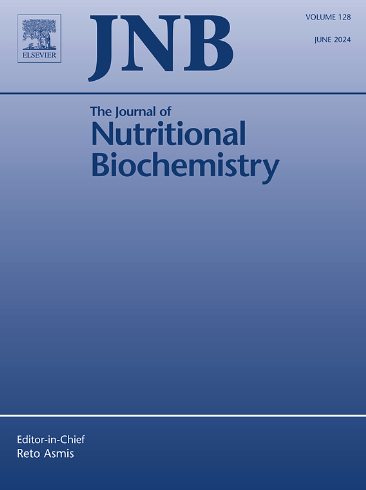通过Nrf-2/SKN-1通路调节地曲霉丁内酯II对秀丽隐杆线虫的神经保护作用。
IF 4.9
2区 医学
Q1 BIOCHEMISTRY & MOLECULAR BIOLOGY
引用次数: 0
摘要
从地曲霉发酵液中分离得到14个化合物,均为首次从地曲霉中分离得到。其中,丁内酯II (A9)具有良好的DPPH自由基清除能力,EC50值为42.05 μM,优于阳性对照药BHT。进一步对秀丽隐杆线虫CL2355的神经保护活性评价表明,丁内酯II可以减轻Aβ,引起趋化性障碍,延长秀丽隐杆线虫的寿命,降低5-HT的敏感性。丁内酯Ⅱ处理显著提高了CL2355基因型线虫的趋化性指数15.06% (P本文章由计算机程序翻译,如有差异,请以英文原文为准。
Neuroprotective effects of butyrolactone II from Aspergillus terreus via Nrf-2/SKN-1 pathway modulation in Caenorhabditis elegans
Fourteen compounds were isolated from the fermentation broth of Aspergillus terreus, all of which were isolated from A. terreus for the first time. Among them, butyrolactone II (A9) had excellent DPPH radical scavenging activity, with an EC50 value of 42.05 µM superior to positive control drug BHT. Further neuroprotective activity evaluation of in Caenorhabditis elegans CL2355 revealed that butyrolactone II could alleviate Aβ, causing chemotaxis disorder, prolonging lifespan of C. elegans, and reducing 5-HT sensitivity. Butyrolactone II treatment significantly elevated the chemotaxis index of genotyped nematode CL2355 by 15.06% (P<0.05), and reduced the sensitivity of nematodes to 5-HT, decreasing the paralysis rate by 9.8% (P<0.05). Moreover, it significantly increased median lifespan and maximum lifespan by 20% and 26% respectively. In the RNA transcriptome, Butyrolactone II caused upregulation of 277 differentially expressed genes and downregulation of 171 differentially expressed genes, inducing the entry of transcription factor SKN-1 into the nucleus and changes in its downstream genes. The annotation and enrichment of GO and KEGG pathways indicated that differentially expressed genes might be related to pathways such as metabolic detoxification, oxidative stress, and lysosomal autophagy. The qRT-PCR validation of gene expression was consistent with transcriptomics. Butyrolactone II could significantly increase the expression of mitochondrial fission factor (mff-2), downstream genes related to SKN-1 (dod-17, gst-38), heat shock protein genes (hsp-17, hsp-12.6), and oxidative stress related genes (cyp-14A5) in nematodes, while having no significant effect on the expression level of gst-33 gene. Taken conclusion, butyrolactone II exerts neuroprotective effects by modulating the Nrf-2/SKN-1 pathway and regulating metabolic pathways, underscoring its potential as a therapeutic strategy for Alzheimer's disease and other related neurodegenerative disorders.
求助全文
通过发布文献求助,成功后即可免费获取论文全文。
去求助
来源期刊

Journal of Nutritional Biochemistry
医学-生化与分子生物学
CiteScore
9.50
自引率
3.60%
发文量
237
审稿时长
68 days
期刊介绍:
Devoted to advancements in nutritional sciences, The Journal of Nutritional Biochemistry presents experimental nutrition research as it relates to: biochemistry, molecular biology, toxicology, or physiology.
Rigorous reviews by an international editorial board of distinguished scientists ensure publication of the most current and key research being conducted in nutrition at the cellular, animal and human level. In addition to its monthly features of critical reviews and research articles, The Journal of Nutritional Biochemistry also periodically publishes emerging issues, experimental methods, and other types of articles.
 求助内容:
求助内容: 应助结果提醒方式:
应助结果提醒方式:


